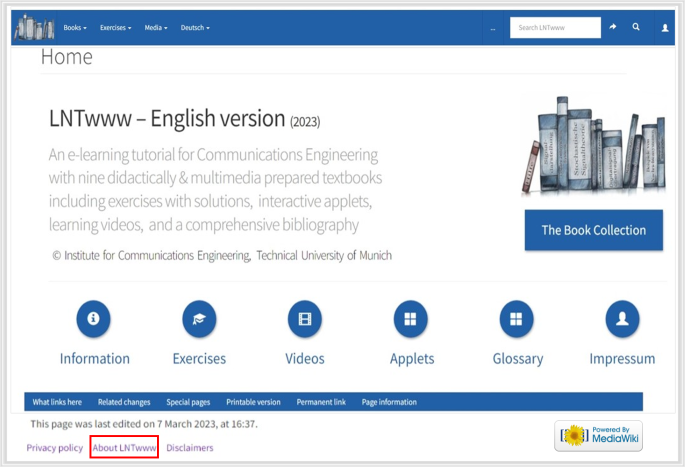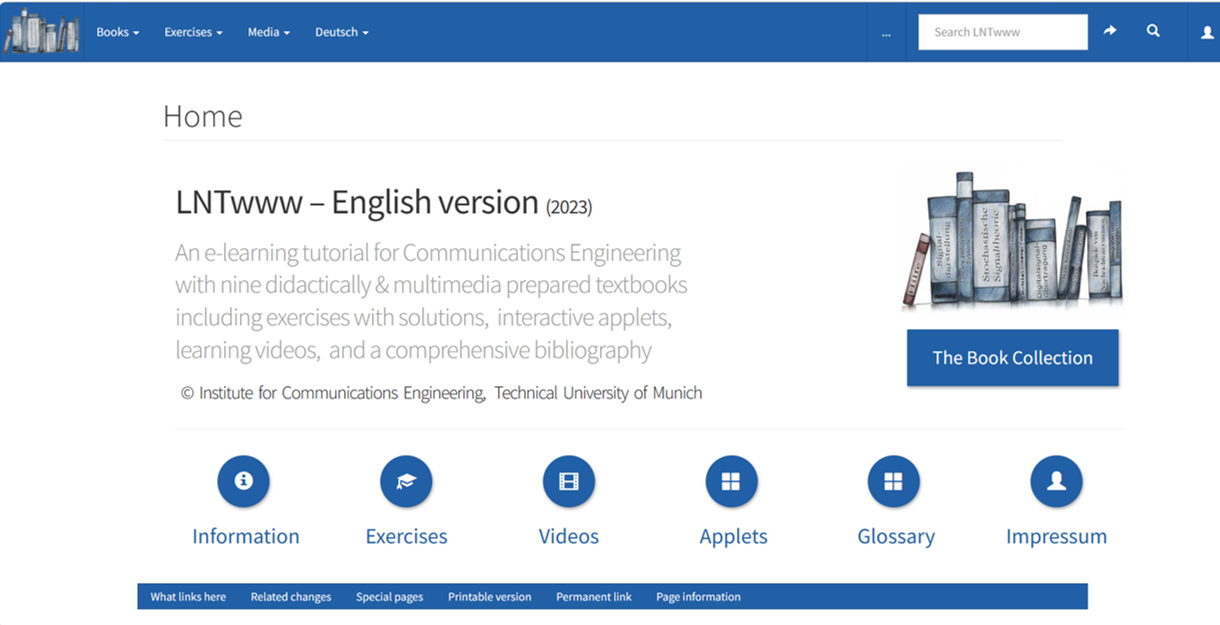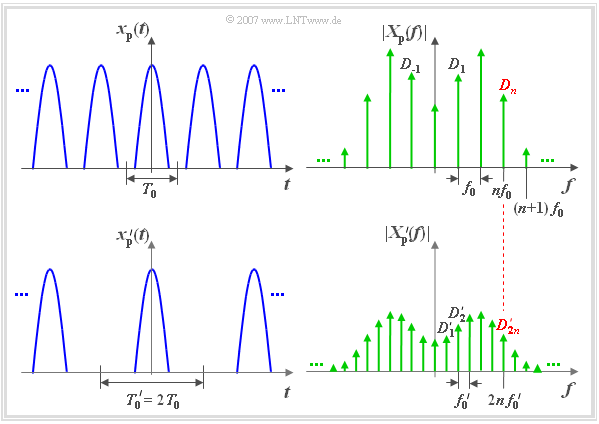Difference between revisions of "An e-learning project for Communications Engineering - LNTwww"
| Line 1: | Line 1: | ||
| − | + | The e-learning project »LNTwww« provides various online courses on the subjects of »Communications Engineering« $\rm (CE)$ and »Information and Communication Technology« $\text{(I&C)}$. The target group of our online offer are students of these or similar disciplines as well as practicing engineers and scientists. | |
| − | [[File:LNTwww2023_StartPage2ndJan2024v2.png|right|frame|Screenshot of the English version [https://en.lntwww.de »en.lntwww.de«]. <u>Note:</u> <br>(1) '''LNTwww''' is acronym of the German term »'''L'''erntutorial für '''N'''achrichten'''T'''echnik im '''w'''orld '''w'''ide '''w'''eb«<br>(2) '''LNT''' | + | »LNTwww« is offered by the [https://www.ce.cit.tum.de/en/lnt/home/ »TUM Institute for Communications Engineering«]. It freely accessible. Registration is not necessary and no system requirements are needed. |
| + | |||
| + | |||
| + | [[File:LNTwww2023_StartPage2ndJan2024v2.png|right|frame|Screenshot of the English version [https://en.lntwww.de »en.lntwww.de«]. <u>Note:</u> <br>(1) '''LNTwww''' is acronym of the German term »'''L'''erntutorial für '''N'''achrichten'''T'''echnik im '''w'''orld '''w'''ide '''w'''eb«<br>(2) '''LNT''' also stands for the German name »'''L'''ehrstuhl für '''N'''achrichten'''T'''echnik« of our chair]] | ||
| − | The »LNTwww& | + | The graph shows the »LNTwww« platform with links to |
*nine didactically and multimedia prepared CE-courses including the associated basics $($signal representation, Fourier transform, stochastic signal theory, ...$)$, | *nine didactically and multimedia prepared CE-courses including the associated basics $($signal representation, Fourier transform, stochastic signal theory, ...$)$, | ||
| Line 15: | Line 18: | ||
| − | |||
| + | It is offered by the TUM Institute for Communications Engineering« and | ||
The German-language version »www.LNTwww.de« was created by members of our Institute between 2001–2021. In spring 2020 we started the English translation, in spring 2023 we finished. | The German-language version »www.LNTwww.de« was created by members of our Institute between 2001–2021. In spring 2020 we started the English translation, in spring 2023 we finished. | ||
Revision as of 19:40, 3 January 2024
The e-learning project »LNTwww« provides various online courses on the subjects of »Communications Engineering« $\rm (CE)$ and »Information and Communication Technology« $\text{(I&C)}$. The target group of our online offer are students of these or similar disciplines as well as practicing engineers and scientists.
»LNTwww« is offered by the »TUM Institute for Communications Engineering«. It freely accessible. Registration is not necessary and no system requirements are needed.

(1) LNTwww is acronym of the German term »Lerntutorial für NachrichtenTechnik im world wide web«
(2) LNT also stands for the German name »Lehrstuhl für NachrichtenTechnik« of our chair
The graph shows the »LNTwww« platform with links to
- nine didactically and multimedia prepared CE-courses including the associated basics $($signal representation, Fourier transform, stochastic signal theory, ...$)$,
- a variety of exercises with detailed solutions,
- some multimedia modules $($learning videos and interactive applets$)$,
- a comprehensive bibliography.
It is offered by the TUM Institute for Communications Engineering« and The German-language version »www.LNTwww.de« was created by members of our Institute between 2001–2021. In spring 2020 we started the English translation, in spring 2023 we finished.
The target group of this online offer are students of »Communications Engineering« as well as practicing engineers. The target group of the e-learning project »LNTwww« are students of »Communications Engineering« as well as practicing engineers.
The e-learning project »LNTwww« stellt verschiedene Online-Kurse zum Thema Communications Engineering bereit. Die Zielgruppe unseres Online-Angebotes sind Studierende dieser oder ähnlicher Fachrichtungen sowie praktizierende Ingenieure und Naturwissenschaftler. is offered by the »TUM Institute for Communications Engineering«. Die Grafik zeigt die Startseite unserer Plattform:
Hier die einzige Grafik entsprechend diesem Link Home und einigen Markierungen. Bildunterschrift:
Home page of the English version with link markers
(Home) https://en.lntwww.de/Home
(A) https://en.lntwww.de/LNTwww:About_LNTwww
(B) https://en.lntwww.de/Book_Overview
(C) https://en.lntwww.de/LNTwww:Information
(D) https://en.lntwww.de/Exercises:Exercise_Overview
(E) https://en.lntwww.de/LNTwww:Videos
(F) https://en.lntwww.de/LNTwww:Applets
(G) https://en.lntwww.de/LNTwww:Glossary
(H) https://en.lntwww.de/LNTwww:LNTwww_Impressum
(I) https://www.lntwww.de/Startseite
All important features of this project are summarized in the file »About LNTwww«, among others:
$\text{Example 1:}$ To illustrate these texts, here is an example of how to use our learning tutorial:
$(1)$ After pressing the »Book Collection« button, a selection screen appears with the nine textbooks as well as the book »Biographies and Bibliographies«.
$(2)$ After selecting the »Information Theory course«, its »start page« appears with links to four main chapters and to exercises, multimedia elements and literature.
$(3)$ We now select the first main chapter »Entropy of Discrete Sources« and of this in turn the first subchapter »Discrete Memoryless Sources« with eight sections.
$(4)$ This exemplary subchapter explains the procedure for calculating the entropy of binary and non-binary sources. As in conventional mathematical and technical literature, the facts are illustrated by texts, models, graphs, diagrams, equations and derivations.
$(5)$ The last two sections of each subchapter are exercises and references to the topic covered.

